Installation and connection of the dishwasher: installation and connection of the dishwasher to the water supply and sewerage
The correct operation of the dishwasher depends not only on the quality of spare parts and assembly. The uninterrupted functioning and normal execution of the main tasks by the unit are affected by the correct connection of the dishwasher to the utilities. Do you want to do this work yourself, but doubt that everything will work out?
We will help you in the implementation of your plan. The article describes in detail the steps of installing the equipment, connecting the outlet, water supply and arranging the drainage system. In order not to encounter an accident, leakage or fast repair, you must adhere to the manufacturer's recommendations indicated in the instructions.
The content of the article:
Selecting a location based on the installation method
The sooner you think about acquiring equipment, the less trouble there will be with further improvement of the kitchen.
The ideal option is a comprehensive repair, including:
- designing a project;
- laying of water supply and sewage pipes;
- conducting separate power lines for powerful units;
- decoration of the room;
- installation of furniture and appliances.
In this case, the risks that there is not enough niche for the dishwasher or its dimensions do not fit are reduced to zero. Walls with connected connectors look neat, safety requirements are observed.
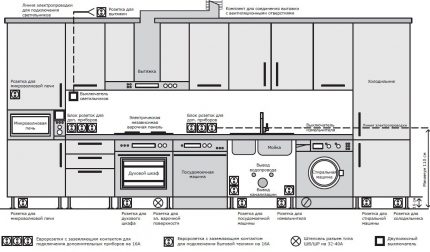
The installation location depends on the type of machine, respectively, on how it is installed.
All devices are usually divided into two categories:
- freestandingportable, representing a mobile unit;
- recessedstationary, for the installation of which a cabinet is required.
For proper installation, the size of the dishwasher is also of great importance. Allocate a subcategory compact cars, with reduced dimensions.
Among them there are both freestanding appliances designed for installation on a countertop or in a cabinet niche, as well as built-in ones.
Options for the location of dishwashers:
You need to think about how and where to install the dishwasher in advance. Mostly, the unit should be correctly positioned relative to the communications - as close as possible to the pipes.
We also recommend that you install cabinets for dishes and other utensils that are designed for washing in the PMM in the accessibility zone.
The cleaning process will be much faster if cleaning plates from large pieces, loading utensils in the dishwasher trays, putting clean dishes on the shelves will happen from the same place.
The importance of using instructions
Manufacturers are responsible for the quality of their products, so new dishwashers have a guarantee - from 12 months to 5 years. It is more often possible to return a faulty Chinese unit to the service within 1 year, European - 2 years.
However, improper installation of the machine, contrary to the requirements of the manufacturer, deprives the buyer of the right to free repair or replacement of equipment.
Therefore, the main document and installation manual for the dishwasher becomes instruction. This is a booklet with a detailed description of the installation and connection of a new dishwasher to the water supply and sewerage.
Also, the instructions contain technical requirements that relate to the parameters of the connected electrical network, pressure in the pipes, etc. The characteristics of the machine also need to be taken into account.
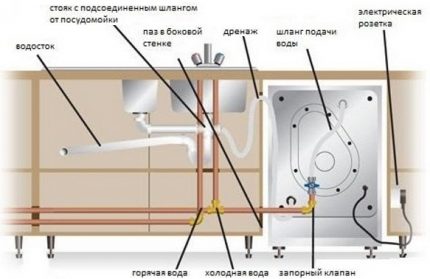
So, fully integrated PMM with a large mass is placed on the floor, additionally fixing on the walls of the cabinet or countertop. But compact models can be integrated into a cabinet that can support their weight, even taking into account the loaded containers and water.
If within six months some dishwasher spare parts will fail due to improper location of the hoses or strong vibration of the case, they will have to be replaced at your own expense - the warranty is voided.
Connecting PMM to communications
In order for the machine to work, it is necessary to ensure the supply of electricity and cold water, as well as to equip the drain of used liquid into the sewer.
If a separate outlet for the PMM is installed during the repair, you can skip the first stage, however, the next two are carried out during the connection in any case.
Stage # 1 - installation of a separate outlet
An extension cord inserted into a common outlet, a filter or a tee is not recommended.
Such "intermediaries" may not withstand the load, fail, or even melt. You will definitely need a separate electrical installation product of the “Euro” standard, with grounding and high degree of protection from moisture.
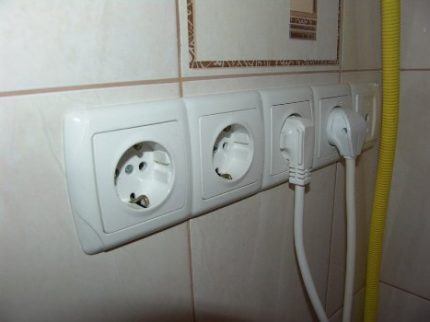
Too close to the floor to fix the outlet block is not advised - during leakage, water can get into the product. The minimum distance from the flooring is 15-20 cm.
This is true for embedded models, when the outlet is placed on the wall behind the dishwasher. For freestanding units, the usual location is at a distance of 40-90 cm from the floor.
In addition to the outlet, a wire is required, preferably in non-combustible insulation and with a section designed for increased load. A suitable option is a copper 3-wire wire VVGNG 3 * 2.5.
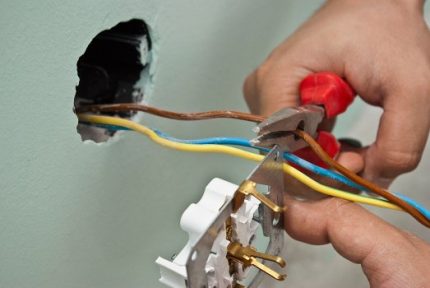
Installation ground outlets refers to basic household skills, so many cope with its installation on their own. However, if skills are not enough, it is better to entrust all work on electrical equipment to a specialist.
From the outlet, the wire stretches to the electrical panel, where a separate circuit breaker. It is recommended to provide similar automatic machines for each powerful household appliance - if necessary, you will not have to disconnect the entire "kitchen" line.
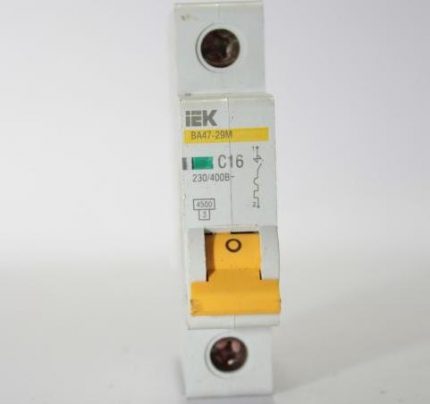
Even if you theoretically know how to install a switch for DIN rail, all electrical work in the dashboard must be performed by a representative of the management company or other service organization.
After the installation is completed, it is necessary to check how the outlet works. To do this, turn on the machine and insert the plug of a simple device, for example, a table lamp, into a socket.
Stage # 2 - ensuring water supply
So that the machine can be used at any convenient time, you should attach the water supply hose to the pipe or flexible wiring with a threaded connection using a tee or adapter.

The length of the water supply hose is 1-1.5 m. It is at such a distance from the highway that manufacturers recommend installing a dishwasher so that it functions correctly.
Procedure:
- unscrew the flexible hose of the mixer from the pipe;
- we connect a tee with sizes ½ inch "mother" and "father" in a straight section, with a ¾-inch outlet on the side and a tap to shut off the water;
- for tightness of the connection we use fum tape or another sealant;
- ¾ inch nozzle output in a convenient direction for connecting the hose;
- we fasten the flexible eyeliner to the ½ inch branch and the dishwasher hose to the side outlet;
- we test the water supply, if necessary we tighten the connections.
Depending on how far the machine is from the sink, this or that connection method is selected.
All methods are functional and in their own way good, so the owners of the unit will have to decide how to connect a new dishwasher with their own hands based on specific conditions.
Connection parts are sold in plumbing stores, so there should be no problems with the purchase of tees, manifolds, seals. Try not to save on details and choose even more expensive, but high-quality components and gaskets.
Features of connecting compact devices
The instructions for mini-dishwashers indicate the installation method without stationary connection to communications. Before washing, the water inlet hose is put on the spout of the mixer, and the drain hose is lowered into the sink.
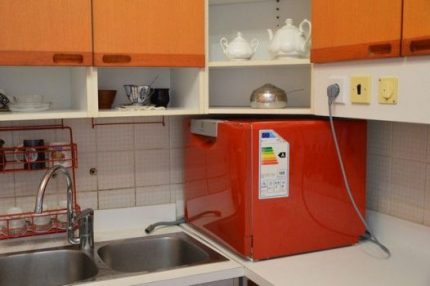
Some use this method, but it is fraught with uncomfortable moments:
- every time you have to do extra actions;
- hoses are visible and spoil the overall look;
- due to frequent connection / disconnection, the connection points quickly become loose and wear out;
- strong water pressure can “knock out” the hose from the sink, as a result, a flood will occur;
- the sink remains busy while the washing and rinsing process is in progress.
Therefore, for reliability, it is better to choose a specific installation location and ensure a constant tight connection.
About connecting to hot water
Buyers consider the possibility of connecting to both pipelines - with hot and cold water - as a useful option and are even ready to overpay for a “useful” addition.
However, there are many reasons why you should not "save" on heating the machine and use hot water:
- the composition of hot water is worse than cold;
- the electronic unit will “fly out” if the water temperature in the network is higher than the programmed one;
- when centralized, hot water is often turned off.
Savings themselves are also being called into question. Modern models are already considered quite economical, given the low power consumption.
And with the use of hot water, some nodes can fail ahead of time, and you will have to spend a significant amount on repairs.
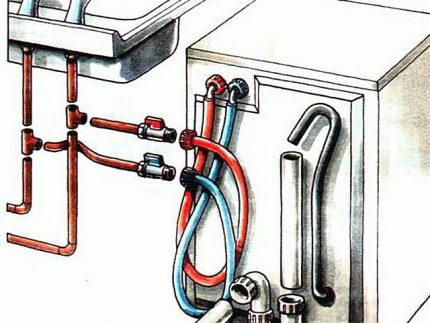
The grossest mistake is to connect the hot line to a device designed exclusively for supplying cold water. Machine parts will not withstand heat and will break quickly.
Stage # 3 - drainage device
Drainage - a necessary condition for the proper operation of the dishwasher, a drain hose is provided for this.
There are two ways to connect it to the sewer line:
- directly into the pipe through a rubber sleeve;
- through a siphon located under the sink.
The second option is the most successful, since it immediately solves all problems: eliminates odors, protects against reverse fluid flow, creates the necessary pressure in the pipe, protects against leaks.
You will have to purchase a new siphon if the old one is not designed to connect household appliances, and consider the location of the drain hose.
In order to simultaneously maintain the tightness of the joints and the normal, without vacuum, pressure in the line, with a direct connection (without a water seal), an “anti-siphon” valve is used. This is an inexpensive plastic product that is inserted directly into the slot in the hose.
On this connection of communications can be considered completed. After the test run, it will become clear how correctly the hose connections are made and whether additional sealing is needed.
Nuances of installing embedded technology
Freestanding units are simply installed in the space provided for them, then connected. Built-in models need to be integrated into the furniture set.
Here are some helpful suggestions that may come in handy during the process. installation of built-in appliances:
- the dimensions of the cabinet for embedding should correspond to the dimensions of the dishwasher body, for comparison, you need to check with the schemes provided by the manufacturer;
- be sure to use the protective devices that are included - a metal bar to strengthen the countertop, a vapor barrier film;
- twist the legs to align the body, usually three - two are in front and one is in the back;
- do not forget to insert the side bushes and fix the case with self-tapping screws;
- Fix decorative panels strictly according to templates or stencils, which are also included in the delivery.
Dishwashers of different manufacturers may have structural differences, so you should rely only on the instructions of a particular model.
The document clearly sets out how to properly install the dishwasher, in what order do the installation and connection of communications.
Conclusions and useful video on the topic
The nuances of connecting hoses to pipes are disclosed in the following video:
Detailed instructions for hanging the facade:
The power supply for the dishwasher is discussed in the following plot:
At first glance, all the steps to install a dishwasher seem simple and do not require special skills. However, during the installation or connection process, questions often arise, therefore, relying on self-reliance alone is not necessary.
If there is no experience in such work, enlist the support of specialists. This will be especially needed where safety regulations are required..
Do you have personal experience installing and connecting a dishwasher? Want to share your knowledge or ask questions about the topic? Please leave comments and participate in discussions - the feedback form is located below.

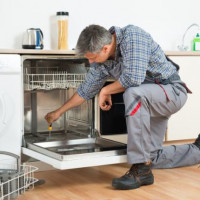 Installing a Bosch dishwasher: how to properly install and connect a dishwasher
Installing a Bosch dishwasher: how to properly install and connect a dishwasher 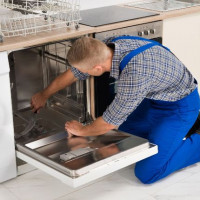 Installation of the built-in dishwasher: step-by-step installation instructions
Installation of the built-in dishwasher: step-by-step installation instructions 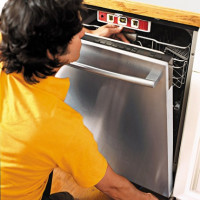 The first start of the dishwasher: how to properly carry out the first inclusion of equipment
The first start of the dishwasher: how to properly carry out the first inclusion of equipment 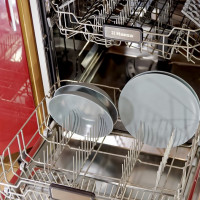 Hansa ZIM 476 H dishwasher overview: functional assistant for one year
Hansa ZIM 476 H dishwasher overview: functional assistant for one year 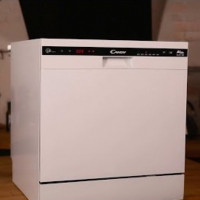 Candy CDCF 6E-07 dishwasher overview: is it worth buying a miniature
Candy CDCF 6E-07 dishwasher overview: is it worth buying a miniature 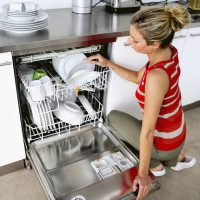 TEN for the Bosch dishwasher: how to choose + replacement instructions
TEN for the Bosch dishwasher: how to choose + replacement instructions  How much does it cost to connect gas to a private house: the price of organizing gas supply
How much does it cost to connect gas to a private house: the price of organizing gas supply  The best washing machines with dryer: model rating and customer tips
The best washing machines with dryer: model rating and customer tips  What is the color temperature of light and the nuances of choosing the temperature of the lamps to suit your needs
What is the color temperature of light and the nuances of choosing the temperature of the lamps to suit your needs  Replacement of a geyser in an apartment: replacement paperwork + basic norms and requirements
Replacement of a geyser in an apartment: replacement paperwork + basic norms and requirements
We chose a dishwasher for a long time and settled on a compact model, which we plan to place under the sink. In this regard, the question arose: is it possible to put it on the bottom of the cabinet under the sink or is it necessary on the floor? The bottom is quite thick, with free space underneath. To clean it - the design of the sink cabinet will be violated. Maybe some additional legs under the bottom do?
For a compact dishwasher, there is no difference on the floor or not. She stands with friends and no problems.
Hello. Additional legs are needed if the bottom of the cabinet bends under the weight of the dishwasher. In this case, the legs will create support, and prevent deformation of the bottom. There is no difference for the device on which surface it stands. The main thing is that it be smooth. You can check the evenness of the bottom of the cabinet using the simplest mechanical level with a bubble (price from 200 rubles).
Hello. The instructions for the dishwasher indicate how to properly position it. Of course, if you violate the instructions, most likely, the warranty will not be valid.
In general, yes, it is possible to install the device in such a way on a stable surface, observing the gap above its upper part (if required by instructions) and safety precautions.
I have long wanted a dishwasher, we even left a place for it right next to the sink. When it was the turn of her purchase, we carefully chose to buy the right one. The installation was not very simple, my husband examined the details and instructions for several days, additionally watched a lot of videos on the Internet. As a result, after several connection tests, the machine was installed and now does its job perfectly.